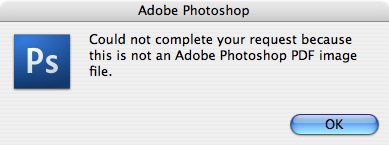All Streets Error Messages
Some favorite error messages while working on the All Streets project (mentioned below). I was initially hoping to use Illustrator to open the generated PDF files (generated from Processing), but Venus informed me that it was not to be:

I’m having difficulties as well. Why did I pay for this software?
Generally, Photoshop is far better engineered so I was hoping that it would be able to rasterize the PDF file instead, never mind the vectors and all.

Oh come on… Just admit that you ran out of memory and can’t deal. Meanwhile, Eugene was helping out with the site, from the other end of iChat:

Oh well.

